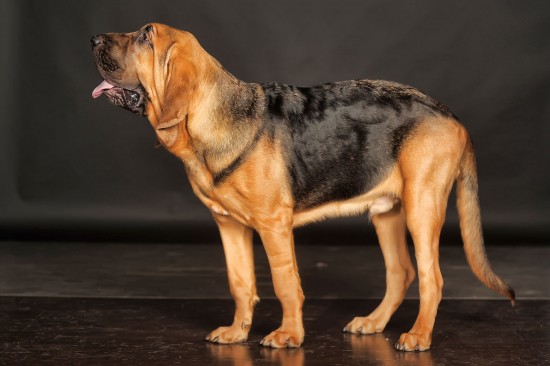

The bloodhound is the dog breed that comes in at the very top of the rankings in terms of canine scenting ability, and is still widely bred for that particular skill. Bloodhounds are notably highly skilled at tracking people, being able to pick up and follow even faint scents left long ago, and over adverse terrain. They are widely used by law enforcement agencies to search for missing persons and escaped fugitives, and can even be used to help to search for missing pets!
The bloodhound is a large breed of dog that can stand up to 27” tall at the withers, and can weigh as much as 72kg, although 40-50kg is the norm. The bloodhound is a large boned, heavyweight dog that has bags of endurance, and is capable of following a scent all day. They can be seen in colours including black, red, liver and tan or a combination thereof, and have short, hard fur and loose fitting skin.
Like all pedigree breeds of dog, the bloodhound may potentially suffer from some problems due to their build and conformation, and can also be prone to inheriting various hereditary health problems present within the breed’s gene pool too. Potential bloodhound owners are advised to research and find out about potential issues prior to making a purchase, and in this article, we will look at the longevity, hereditary health and conformation of the bloodhound in more detail. Read on to learn more.
The bloodhound’s average lifespan is unfortunately among the lowest of all pedigree dogs, with their median longevity identified as just 6.75 years as a of a 2004 survey. The oldest dog present within the survey reached 12.1 years of age, but this is considered to be incredibly old for a dog of the breed. A later survey conducted in 2013 identified a rise in the median lifespan of the breed, falling at 8.25 years, which is still very low across pedigree breeds as a whole.
The main recorded cause of death within the breed is noted as bloat or gastric dilation volvulus, which was responsible for the death of 34% of the 2004 survey group.
The coefficient of inbreeding statistic for the bloodhound breed is 11.7%, meaning that the bloodhound breed is subject to a reasonable degree of inbreeding in order to maintain viable pedigree breed lines. Ideally, the coefficient of inbreeding figure for potential parent dogs of the breed should be lower than this figure.
The bloodhound is one of fifteen dog breeds recognised by the UK Kennel Club as “high profile dog breeds,” meaning that the breed is recognised as having a significant number of hereditary problems, which require careful monitoring and responsible breeding to improve the breed’s overall health.
The British Veterinary Association recommends pre-breeding health screening for potential parent dogs for the following conditions and problems:
Various health problems may arise due to the conformation of the bloodhound itself, which all potential owners should be aware of.
The deep chests of the breed make the bloodhound particularly vulnerable to developing bloat, or gastric torsion, and all bloodhound owners should familiarise themselves with the symptoms of the condition, as it is acute in onset and will soon prove fatal without prompt treatment. The loose skin of the breed can also lead to problems such as irritations and infections, as dirt and bacteria can become trapped within the skin folds. The eyes of the breed also are a significant concern, and may be prone to eyelid entropion, cherry eye, dry eyes and general infections and problems.
The long, dangling ears of the breed too means that they may be prone to picking up dirt and debris, requiring regular cleaning to prevent the development of infections.
As well as the various conformation-based and hereditary health issues mentioned above, the bloodhound breed has also been identified to have an elevated propensity to a couple of other conditions, for which pre-breeding testing is not available.
Skin fold dermatitis and other problems with the skin, including allergies, sensitivities and inflammations are all relatively common across the breed as a whole. The breed is also prone to aortic stenosis, a narrowing of the arteries of the heart, which can lead to congestive heart failure over time.
Copyright © 2005-2016 Pet Information All Rights Reserved
Contact us: www162date@outlook.com